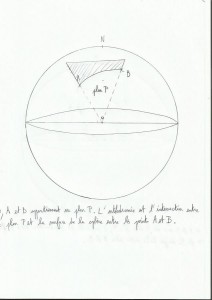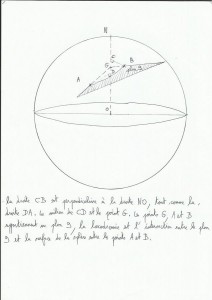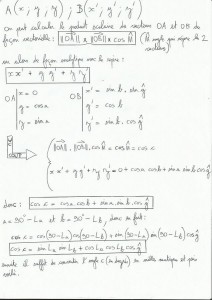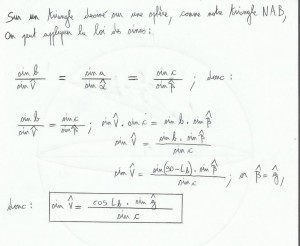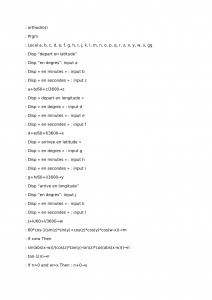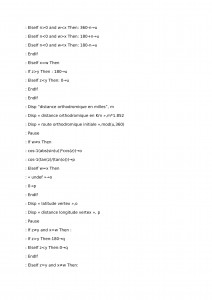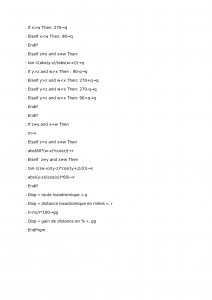Normally on a flat surface the shortest distance between two points is the line passing on those points, Point bar. On a sphere such as the earth, it gets complicated ; then we will talk about rhumb line and orthodromy (see the page on the Mercator projection). The shortest distance on the globe between two positions is orthodromy : it's the path confounded with the half 's great cercle of earth, half great cercle is a plan which cuts sphere's center and two positions. the great cercle is a cercle able to be drawn on the sphere with a perimeter equal to the sphere. If on the globe we follow a road north / south or south / north( if we follow a meridian), or if we follow the equator way, we will be already on an orthodromy way, so for the next calculations displayed in those cases we don't care.
Orthodromy's exemple:
The rhumb line is the line that you draw on a Mercator classic navigation's chart (excepted courses which follows equator or a meridian), it cut meridians with the same angle every times. In fact, because of mercator's influence it's not the shortest way; if we would draw this shortest way on the chart, orthodromy, it would not be drawn like a line but like a curve. If we would be on north hemisphere it would be curved on north, and it would be the contrary for south hemisphere (the more we will be closer to poles, the more it will be curved). Basically orthodromy is an interesting problem for long navigations, rather close to the poles and more oriented east / west or west / east. in some few words, for a sunday's little pedestrian walk it's not useful to be focused on it.
Rhumb line's exemple:
For calculations it's easy we will use the same tricks already employed for the height line : Pythagore, scalar products, trigonometry and spheric trigonometry. The only notion to add up is the sinus law (helpful to find the departure heading of an orthodromy way).
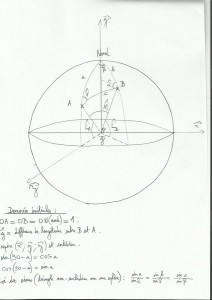 1) Orthodromy's distance calculation (on the draw, c distance, in fact M angle)
1) Orthodromy's distance calculation (on the draw, c distance, in fact M angle)
In the draw, we symbolise earth with a sphere with a radius 1, with an o center and drawn in a cartesian frame of reference (x;y;z) with an o origin too. points A, B and N (for north) are on the sphere so OA=OB=ON=1. A point belongs to plan (y;z), so it has o coordinate on x line. g angle is longitude's difference between B and A, g never overtakes 90 degrees . La angle is A's latitude and Lb angle is B's latitude:
2) V angle calculation
V angle gives the departure heading to use when we want to follow orthodromy:
In fact, during a navigation as soon as we have an accurate position we have to calculate this angle again to situate the boat precisely on orthodromy. In practice this is not always useful to follow before any reason this road, weather systems will usually be the priority. But try to s & rsquo; approach it on a sunbed for example can allow d & rsquo; save miles when opting for a composite road weather / orthodromy.
PS : in the Article “programming a TI89 for navigation”, there is a small program given to calculate the great circle distance and the & rsquo; angle V. Well it sucks…With the & rsquo; d & rsquo assistance; a good book (high seas of olive stern-Veyrin) j & rsquo; as did another that compares more the gain between the great circle route and rhumb, and calculates the vertex.
The program below gives indeed the absolute value of the vertex in latitude, longitude and distance relative to the starting point, only on well oriented roads east / west. It gives an approximation of the rhumb line (distance), there is a more precise formula (see wikipépé) but I don & rsquo; have not succeeded in the program.
Calculation program of & rsquo; orthodromy:
J & rsquo; have verified the proper operation of the program with the site “https://www.aero-training.fr/calculer-une-orthodromie.html”. it works very well to the great circle distance and bearing great circle, as the course of the rhumb line. For remote rhumb remains accurate but it loses precision beyond 400 mn.
